BMW X5 2004 E53 Central Body Electronics Owner's Manual
Manufacturer: BMW, Model Year: 2004, Model line: X5, Model: BMW X5 2004 E53Pages: 64, PDF Size: 4.03 MB
Page 21 of 64
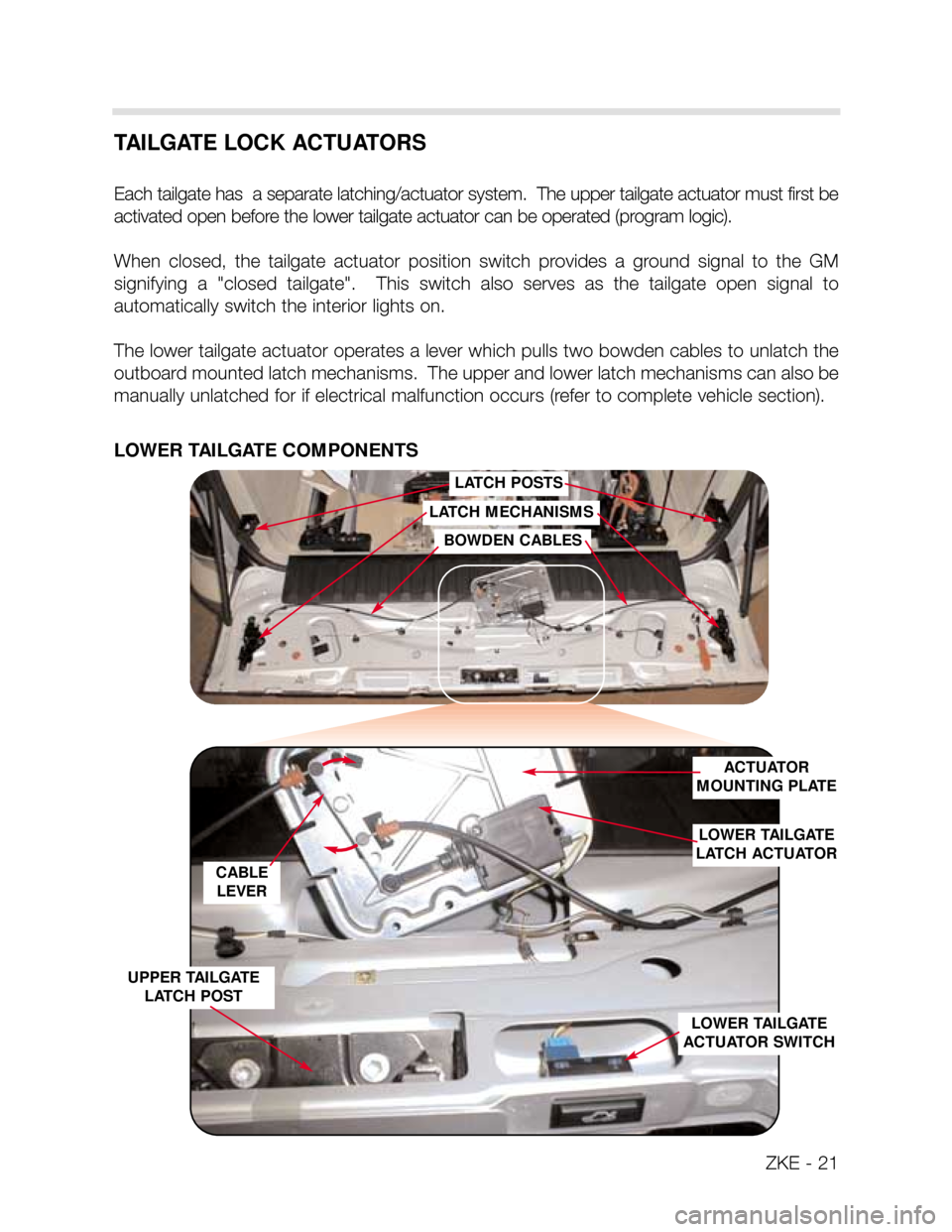
ZKE - 21
LOWER TAILGATE COMPONENTS
BOWDEN CABLES
LATCH POSTS
LATCH MECHANISMS
LOWER TAILGATE
LATCH ACTUATOR
ACTUATOR
MOUNTING PLATE
LOWER TAILGATE
ACTUATOR SWITCH
UPPER TAILGATE
LATCH POST
CABLE
LEVER
TAILGATE LOCK ACTUATORS
Each tailgate has a separate latching/actuator system. The upper tailgate actuator must first be
activated open before the lower tailgate actuator can be operated (program logic).
When closed, the tailgate actuator position switch provides a ground signal to the GM
signifying a "closed tailgate". This switch also serves as the tailgate open signal to
automatically switch the interior lights on.
The lower tailgate actuator operates a lever which pulls two bowden cables to unlatch the
outboard mounted latch mechanisms. The upper and lower latch mechanisms can also be
manually unlatched for if electrical malfunction occurs (refer to complete vehicle section).
Page 22 of 64
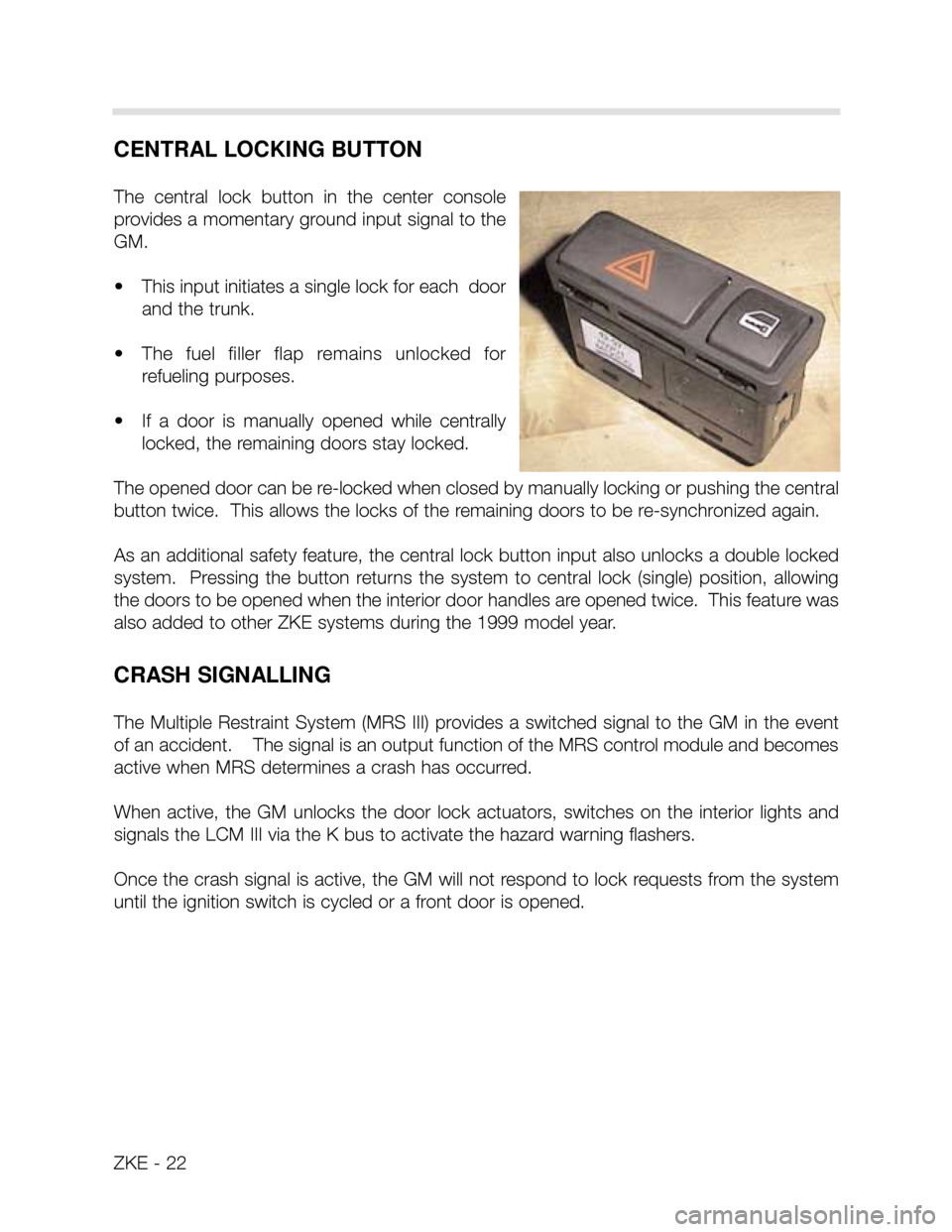
ZKE - 22
CENTRAL LOCKING BUTTON
The central lock button in the center console
provides a momentary ground input signal to the
GM.
• This input initiates a single lock for each door
and the trunk.
• The fuel filler flap remains unlocked for
refueling purposes.
• If a door is manually opened while centrally
locked, the remaining doors stay locked.
The opened door can be re-locked when closed by manually locking or pushing the central
button twice. This allows the locks of the remaining doors to be re-synchronized again.
As an additional safety feature, the central lock button input also unlocks a double locked
system. Pressing the button returns the system to central lock (single) position, allowing
the doors to be opened when the interior door handles are opened twice. This feature was
also added to other ZKE systems during the 1999 model year.
CRASH SIGNALLING
The Multiple Restraint System (MRS III) provides a switched signal to the GM in the event
of an accident. The signal is an output function of the MRS control module and becomes
active when MRS determines a crash has occurred.
When active, the GM unlocks the door lock actuators, switches on the interior lights and
signals the LCM III via the K bus to activate the hazard warning flashers.
Once the crash signal is active, the GM will not respond to lock requests from the system
until the ignition switch is cycled or a front door is opened.
Page 23 of 64
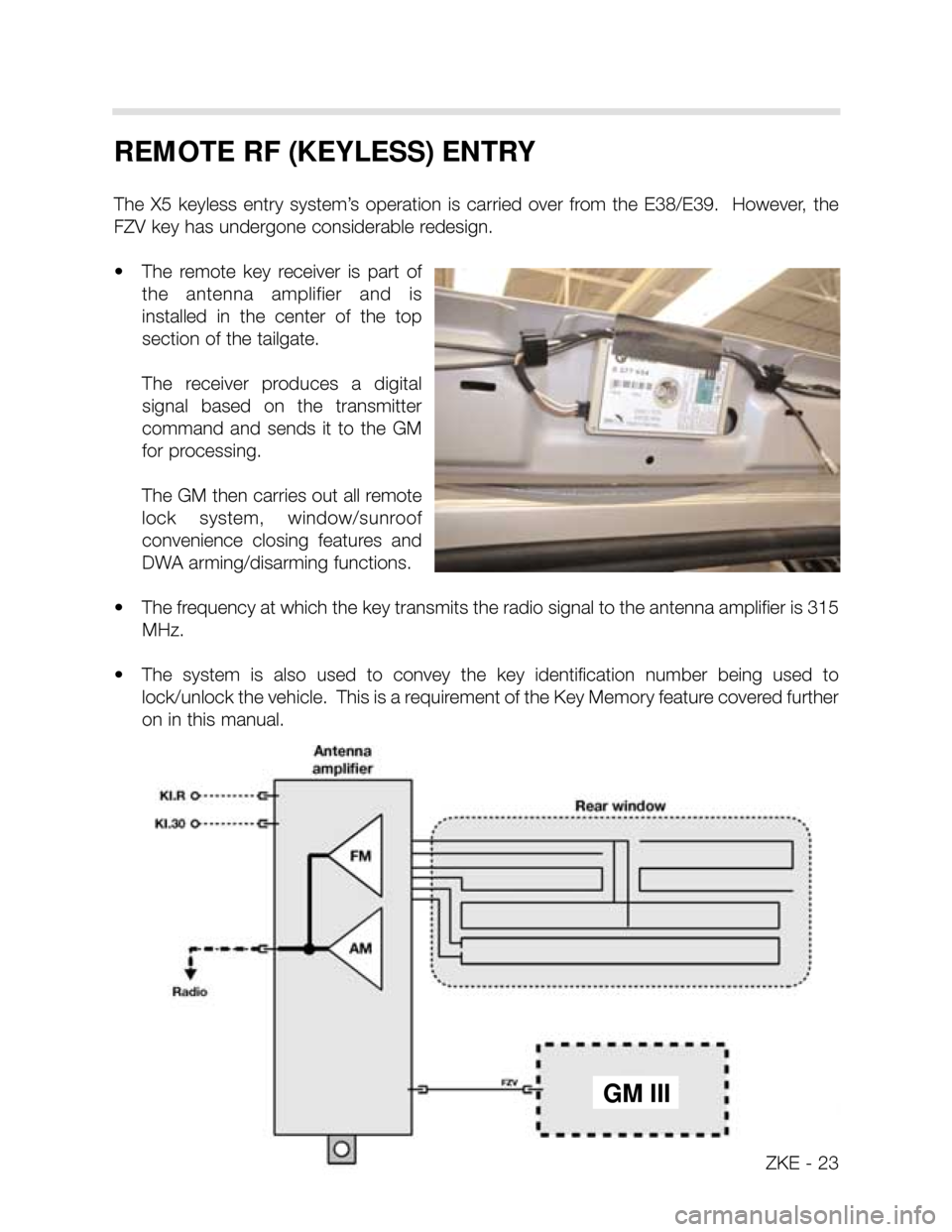
REMOTE RF (KEYLESS) ENTRY
The X5 keyless entry system’s operation is carried over from the E38/E39. However, the
FZV key has undergone considerable redesign.
• The remote key receiver is part of
the antenna amplifier and is
installed in the center of the top
section of the tailgate.
The receiver produces a digital
signal based on the transmitter
command and sends it to the GM
for processing.
The GM then carries out all remote
lock system, window/sunroof
convenience closing features and
DWA arming/disarming functions.
• The frequency at which the key transmits the radio signal to the antenna amplifier is 315
MHz.
• The system is also used to convey the key identification number being used to
lock/unlock the vehicle. This is a requirement of the Key Memory feature covered further
on in this manual.
GM III
ZKE - 23
GM III
Page 24 of 64
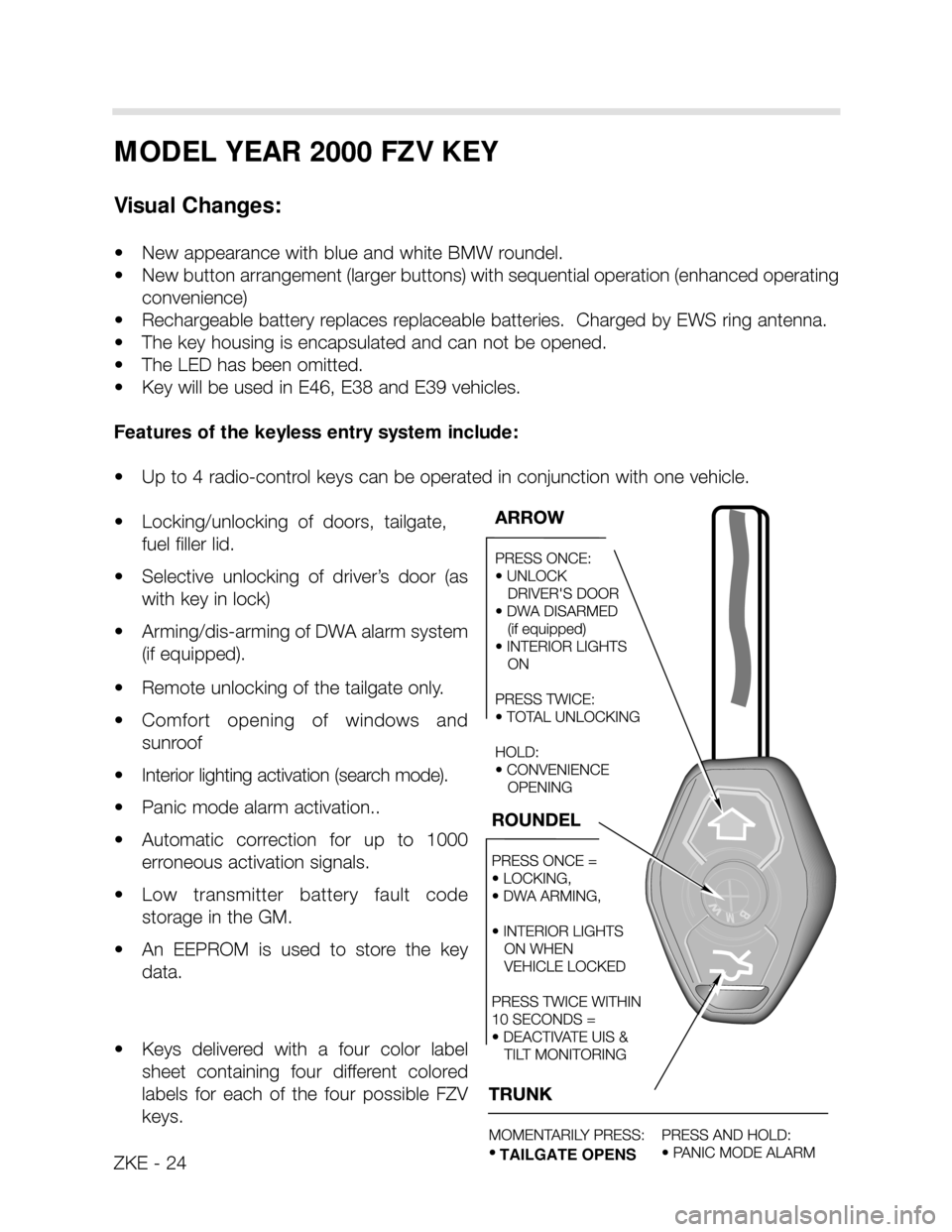
MODEL YEAR 2000 FZV KEY
Visual Changes:
• New appearance with blue and white BMW roundel.
• New button arrangement (larger buttons) with sequential operation (enhanced operating
convenience)
• Rechargeable battery replaces replaceable batteries. Charged by EWS ring antenna.
• The key housing is encapsulated and can not be opened.
• The LED has been omitted.
• Key will be used in E46, E38 and E39 vehicles.
Features of the keyless entry system include:
• Up to 4 radio-control keys can be operated in conjunction with one vehicle.
• Locking/unlocking of doors, tailgate,
fuel filler lid.
• Selective unlocking of driver’s door (as
with key in lock)
• Arming/dis-arming of DWA alarm system
(if equipped).
• Remote unlocking of the tailgate only.
• Comfort opening of windows and
sunroof
• Interior lighting activation (search mode).
• Panic mode alarm activation..
• Automatic correction for up to 1000
erroneous activation signals.
• Low transmitter battery fault code
storage in the GM.
• An EEPROM is used to store the key
data.
• Keys delivered with a four color label
sheet containing four different colored
labels for each of the four possible FZV
keys.
ZKE - 24TAILGATE OPENS
Page 25 of 64
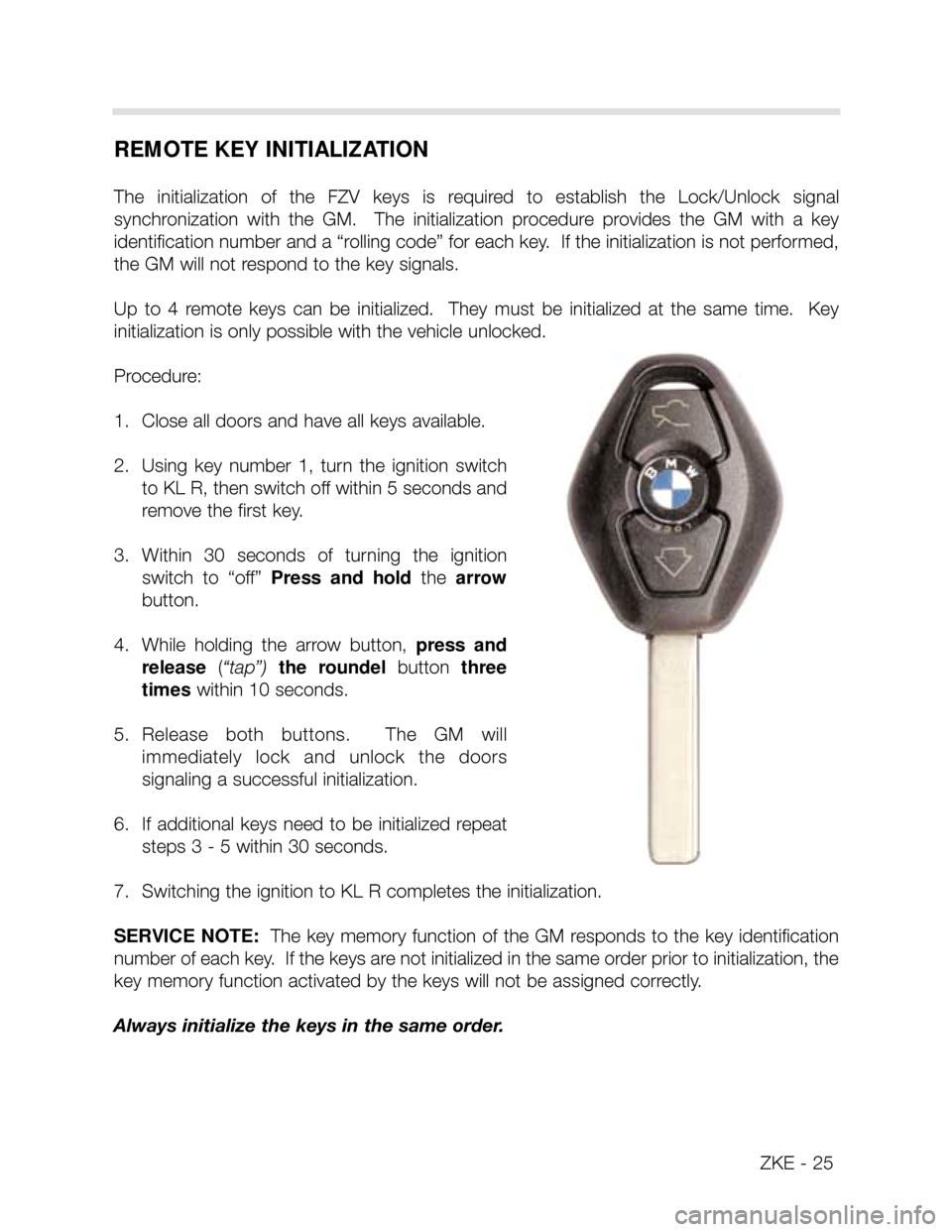
REMOTE KEY INITIALIZATION
The initialization of the FZV keys is required to establish the Lock/Unlock signal
synchronization with the GM. The initialization procedure provides the GM with a key
identification number and a “rolling code” for each key. If the initialization is not performed,
the GM will not respond to the key signals.
Up to 4 remote keys can be initialized. They must be initialized at the same time. Key
initialization is only possible with the vehicle unlocked.
Procedure:
1. Close all doors and have all keys available.
2. Using key number 1, turn the ignition switch
to KL R, then switch off within 5 seconds and
remove the first key.
3. Within 30 seconds of turning the ignition
switch to “off” Press and holdthe arrow
button.
4. While holding the arrow button, press and
release(“tap”) the roundel button three
timeswithin 10 seconds.
5. Release both buttons. The GM will
immediately lock and unlock the doors
signaling a successful initialization.
6. If additional keys need to be initialized repeat
steps 3 - 5 within 30 seconds.
7. Switching the ignition to KL R completes the initialization.
SERVICE NOTE:The key memory function of the GM responds to the key identification
number of each key. If the keys are not initialized in the same order prior to initialization, the
key memory function activated by the keys will not be assigned correctly.
Always initialize the keys in the same order.
ZKE - 25
Page 26 of 64
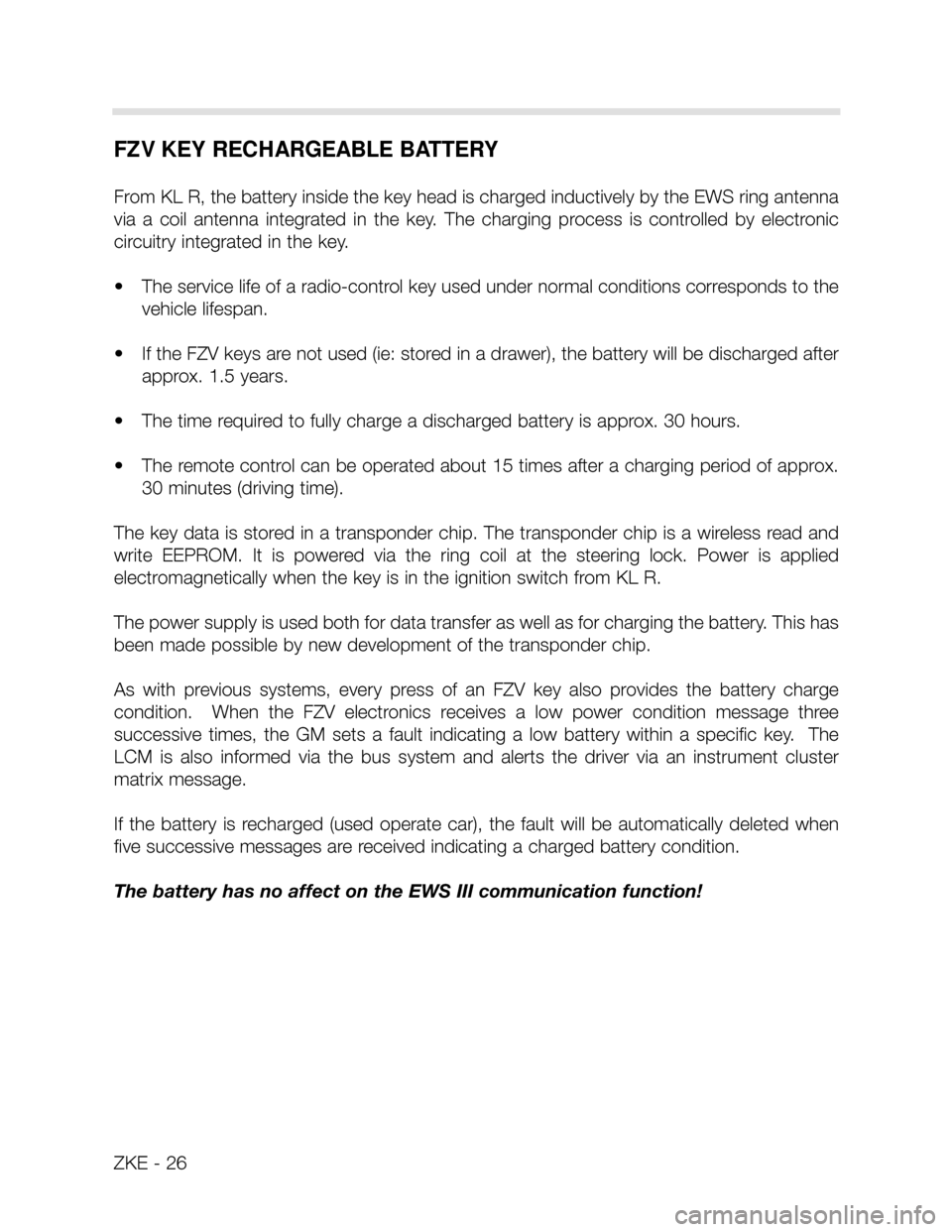
FZV KEY RECHARGEABLE BATTERY
From KL R, the battery inside the key head is charged inductively by the EWS ring antenna
via a coil antenna integrated in the key. The charging process is controlled by electronic
circuitry integrated in the key.
• The service life of a radio-control key used under normal conditions corresponds to the
vehicle lifespan.
• If the FZV keys are not used (ie: stored in a drawer), the battery will be discharged after
approx. 1.5 years.
• The time required to fully charge a discharged battery is approx. 30 hours.
• The remote control can be operated about 15 times after a charging period of approx.
30 minutes (driving time).
The key data is stored in a transponder chip. The transponder chip is a wireless read and
write EEPROM. It is powered via the ring coil at the steering lock. Power is applied
electromagnetically when the key is in the ignition switch from KL R.
The power supply is used both for data transfer as well as for charging the battery. This has
been made possible by new development of the transponder chip.
As with previous systems, every press of an FZV key also provides the battery charge
condition. When the FZV electronics receives a low power condition message three
successive times, the GM sets a fault indicating a low battery within a specific key. The
LCM is also informed via the bus system and alerts the driver via an instrument cluster
matrix message.
If the battery is recharged (used operate car), the fault will be automatically deleted when
five successive messages are received indicating a charged battery condition.
The battery has no affect on the EWS III communication function!
ZKE - 26
Page 27 of 64
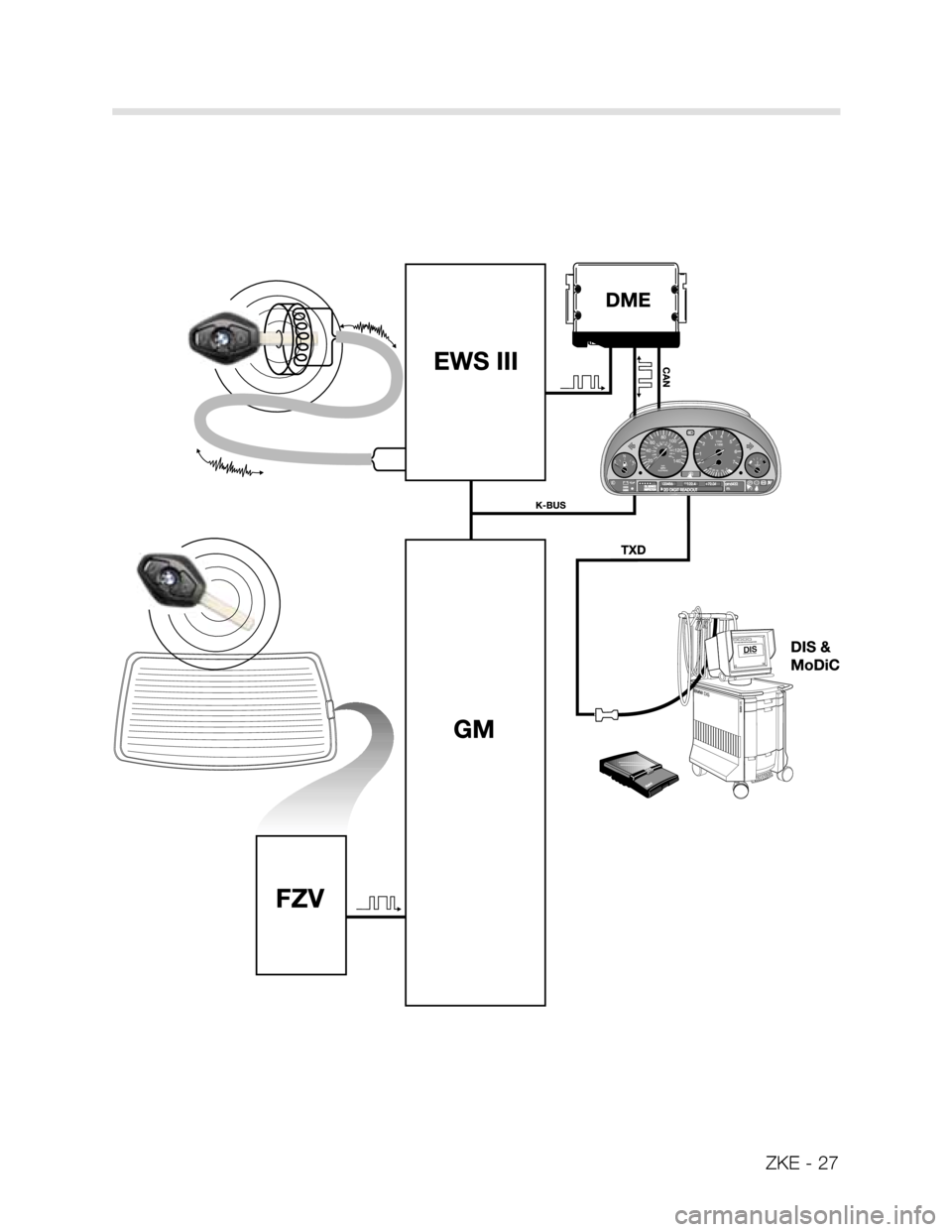
ZKE - 27
Page 28 of 64
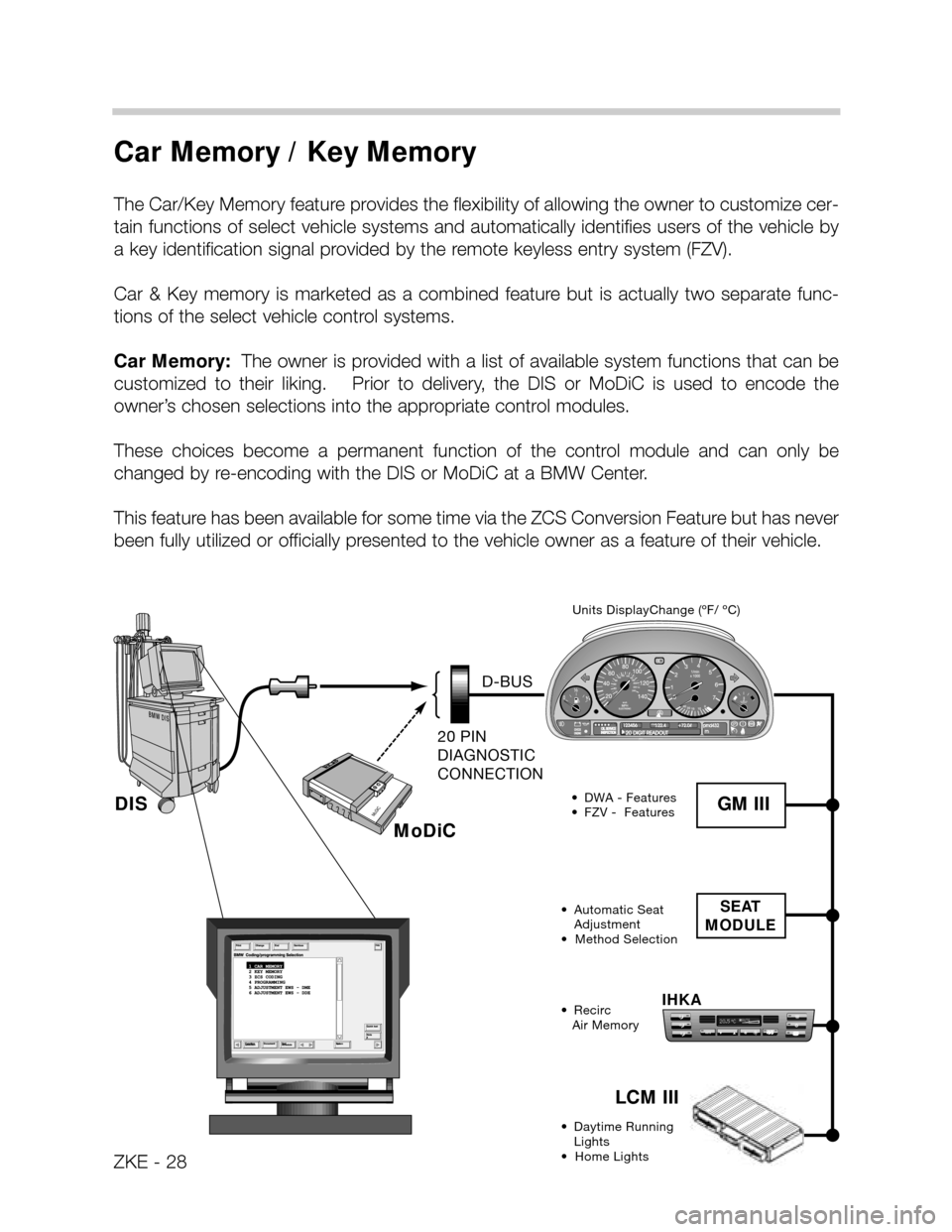
Car Memory / Key Memory
The Car/Key Memory feature provides the flexibility of allowing the owner to customize cer-
tain functions of select vehicle systems and automatically identifies users of the vehicle by
a key identification signal provided by the remote keyless entry system (FZV).
Car & Key memory is marketed as a combined feature but is actually two separate func-
tions of the select vehicle control systems.
Car Memory: The owner is provided with a list of available system functions that can be
customized to their liking. Prior to delivery, the DIS or MoDiC is used to encode the
owner’s chosen selections into the appropriate control modules.
These choices become a permanent function of the control module and can only be
changed by re-encoding with the DIS or MoDiC at a BMW Center.
This feature has been available for some time via the ZCS Conversion Feature but has never
been fully utilized or officially presented to the vehicle owner as a feature of their vehicle.
Units DisplayChange (ºF/ ºC)
• DWA - Features
• FZV - Features
• Automatic Seat
Adjustment
• Method Selection
• Recirc
Air Memory
• Daytime Running
Lights
• Home Lights
UNLEADED GASOLINE ONLY01
220km/hMPH1/min
x1000
40 6080100120
140
160
180
200
220
240
1
023
4
5
6
75030
20
15
1220 406080
100
120
1401
1
MoDiC
20 PIN
DIAGNOSTIC
CONNECTION
MoDiC
D-BUS
DIS
A
SEAT
MODULE
GMV
IHKA
LSZ
ZKE - 28
LCM III
GM III
Page 29 of 64
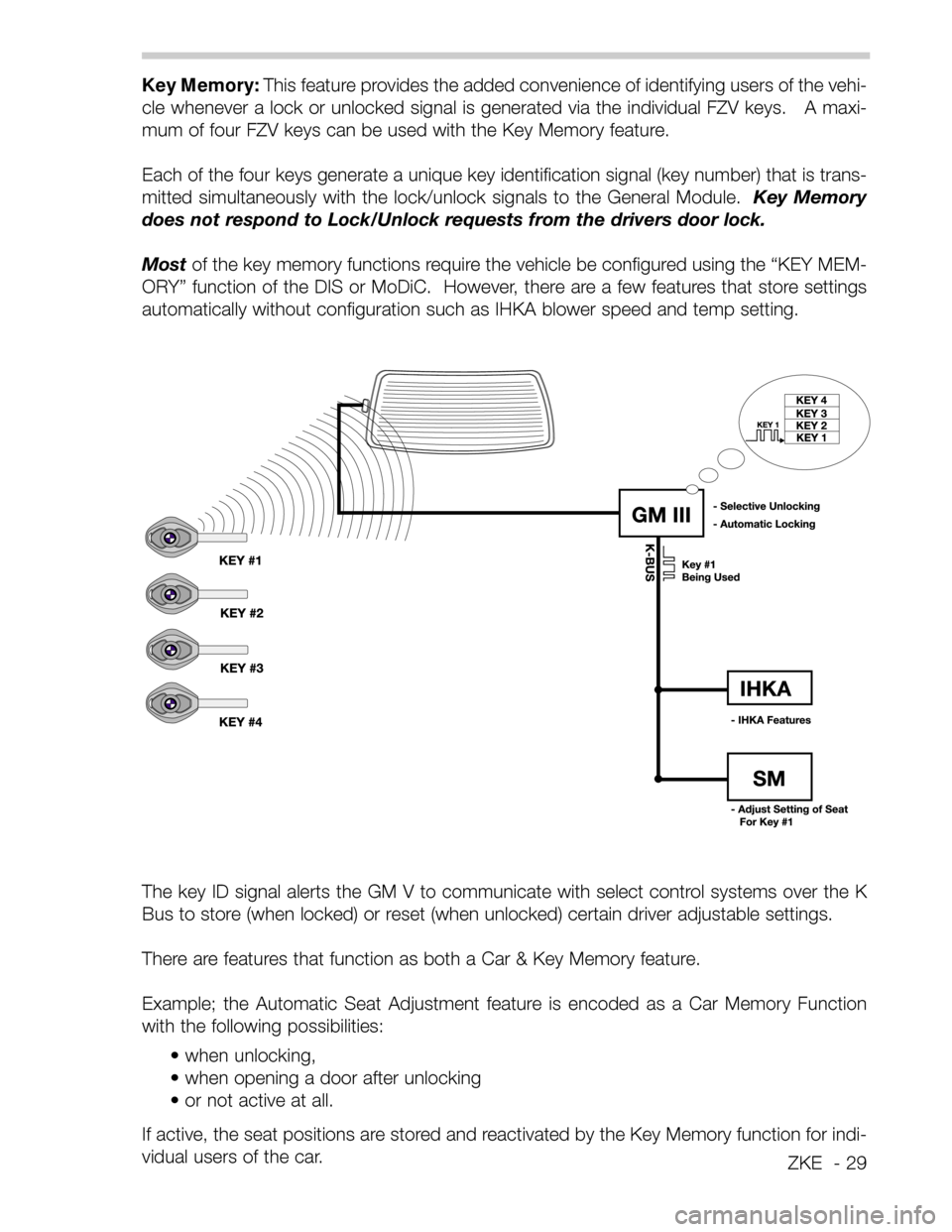
Key Memory: This feature provides the added convenience of identifying users of the vehi-
cle whenever a lock or unlocked signal is generated via the individual FZV keys. A maxi-
mum of four FZV keys can be used with the Key Memory feature.
Each of the four keys generate a unique key identification signal (key number) that is trans-
mitted simultaneously with the lock/unlock signals to the General Module. Key Memory
does not respond to Lock/Unlock requests from the drivers door lock.
Mostof the key memory functions require the vehicle be configured using the “KEY MEM-
ORY” function of the DIS or MoDiC. However, there are a few features that store settings
automatically without configuration such as IHKA blower speed and temp setting.
The key ID signal alerts the GM V to communicate with select control systems over the K
Bus to store (when locked) or reset (when unlocked) certain driver adjustable settings.
There are features that function as both a Car & Key Memory feature.
Example; the Automatic Seat Adjustment feature is encoded as a Car Memory Function
with the following possibilities:
• when unlocking,
• when opening a door after unlocking
• or not active at all.
If active, the seat positions are stored and reactivated by the Key Memory function for indi-
vidual users of the car.
ZKE - 29
Page 30 of 64
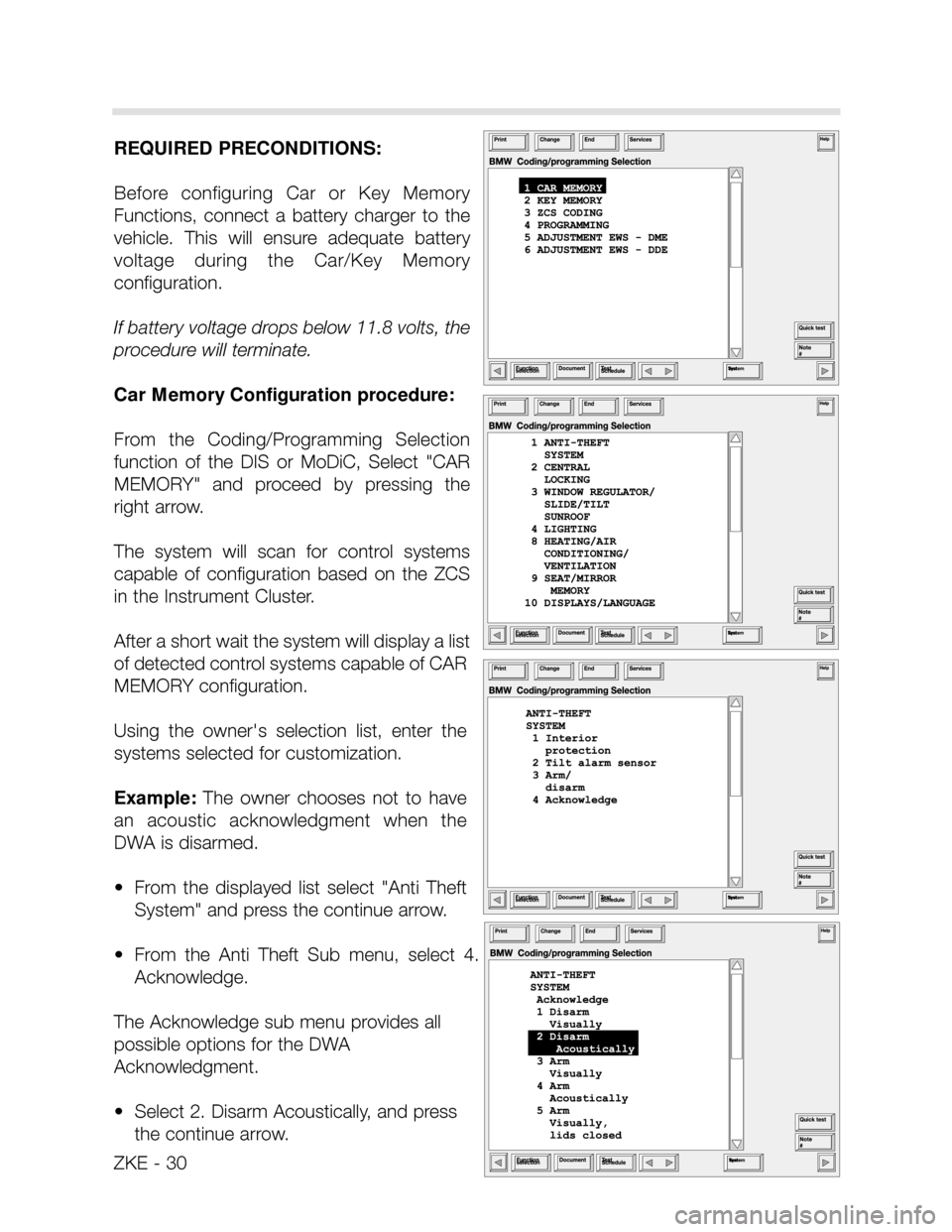
ZKE - 30
REQUIRED PRECONDITIONS:
Before configuring Car or Key Memory
Functions, connect a battery charger to the
vehicle. This will ensure adequate battery
voltage during the Car/Key Memory
configuration.
If battery voltage drops below 11.8 volts, the
procedure will terminate.
Car Memory Configuration procedure:
From the Coding/Programming Selection
function of the DIS or MoDiC, Select "CAR
MEMORY" and proceed by pressing the
right arrow.
The system will scan for control systems
capable of configuration based on the ZCS
in the Instrument Cluster.
After a short wait the system will display a list
of detected control systems capable of CAR
MEMORY configuration.
Using the owner's selection list, enter the
systems selected for customization.
Example:The owner chooses not to have
an acoustic acknowledgment when the
DWA is disarmed.
• From the displayed list select "Anti Theft
System" and press the continue arrow.
• From the Anti Theft Sub menu, select 4.
Acknowledge.
The Acknowledge sub menu provides all
possible options for the DWA
Acknowledgment.
• Select 2. Disarm Acoustically, and press
the continue arrow.